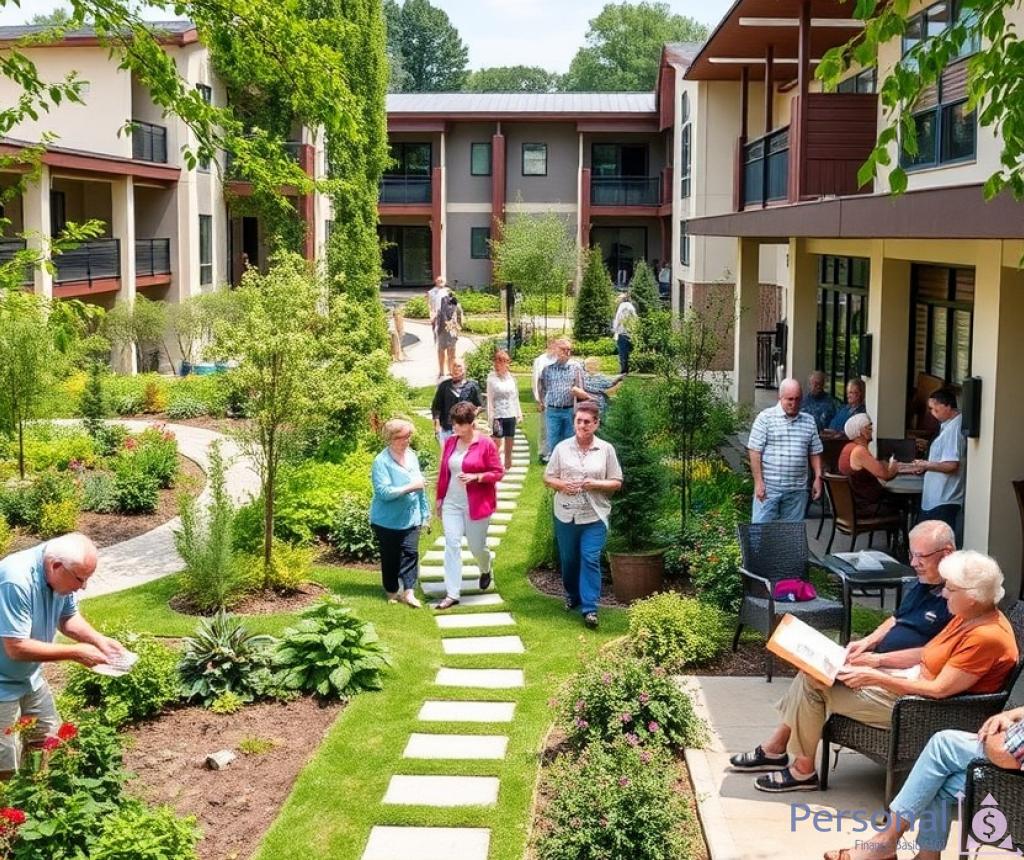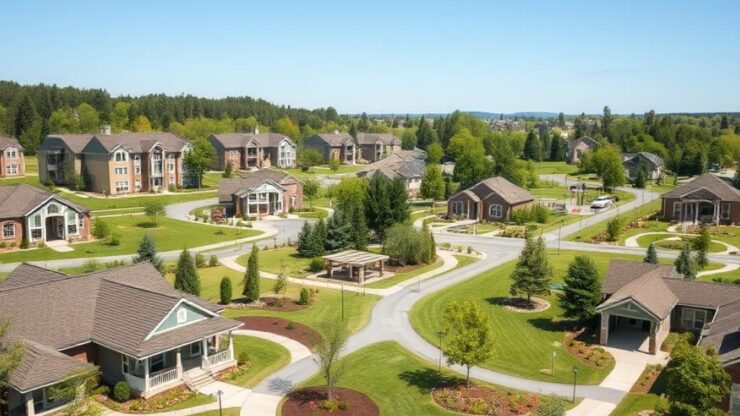Independent Living Communities

Independent living communities serve as a perfect blend of autonomy and support, catering specifically to seniors who value their independence yet appreciate the availability of services that can enhance their quality of life. These communities are designed to provide a nurturing environment that promotes a fulfilling lifestyle while offering various levels of assistance as needed. Residents can enjoy their own private living spaces while having access to communal amenities and activities that foster social interaction.
When considering independent living communities, it’s essential to understand what features and amenities can significantly impact your living experience. These communities often provide a range of services aimed at improving the quality of life for residents. Below is a list of common features that you might find in these communities:
- Housing Options: Various styles such as apartments, cottages, or villas.
- Meal Services: On-site dining facilities offering nutritious meals.
- Social Activities: Organized events and outings to enhance community engagement.
- Transportation Services: Scheduled transportation for shopping, medical appointments, and outings.
- Security Features: 24-hour emergency response systems and secured entrances.
Selecting an independent living community involves careful consideration of several factors to ensure it meets your needs and preferences. Here are some vital elements to reflect on during your search:
- Location: Proximity to family, friends, and essential services.
- Cost: Understanding the pricing structure and what is included in the fees.
- Community Culture: The overall atmosphere and values upheld by the residents and staff.
- Services Offered: A clear understanding of the level of assistance available.
- Future Care Options: Availability of additional care services should health needs change.
Assisted Living Facilities
As individuals navigate the complex journey of aging, many find themselves requiring additional support while still wishing to maintain their independence. Assisted living facilities emerge as a vital solution, bridging the gap between fully independent living and skilled nursing care. These facilities are tailored for seniors who may need help with daily activities, yet do not require the intensive medical care found in nursing homes. By providing personalized assistance in a vibrant community, assisted living facilities foster a sense of belonging and enhance the quality of life for their residents.
In the realm of retirement communities, assisted living facilities stand out due to their unique combination of services and lifestyle options. These facilities are designed to accommodate seniors who may require help with activities such as bathing, dressing, and medication management. What differentiates assisted living from other forms of senior housing is the balance it strikes between support and independence. Residents enjoy their own private living quarters, customized care plans, and access to communal activities, creating an environment that promotes both social engagement and personal freedom.
Choosing the right assisted living facility is a critical decision that requires careful evaluation of several factors. It is essential to consider the level of care provided, as different facilities may offer varying degrees of assistance. Potential residents should assess the facility’s staffing ratios and the qualifications of the caregivers to ensure they will receive the necessary support. Additionally, the community culture plays a significant role in the overall experience; visiting the facility to interact with staff and residents can provide invaluable insights. Finally, understanding the financial aspects, including what services are included in the monthly fees and any potential additional costs, is crucial for long-term planning.
A comprehensive comparison of different assisted living facilities can help potential residents and their families make informed decisions. It is advisable to create a matrix that evaluates key factors such as location, care services, cost, and amenities. For instance, a table can be useful in summarizing these differences:
| Facility Name | Location | Cost (Monthly) | Care Services Offered | Amenities |
|---|---|---|---|---|
| Sunshine Haven | City Center | $4,200 | Personal care, medication management | Pool, fitness center, garden |
| Greenfield Gardens | Suburb | $3,800 | Daily living assistance, wellness programs | Café, activity rooms, transportation |
| Maplewood Retreat | Near Park | $4,500 | Memory care, skilled nursing | Library, art studio, community events |
By carefully evaluating these elements, families can choose a facility that aligns with their loved one’s needs, ensuring a smooth transition into a supportive living environment. As the demand for assisted living facilities continues to grow, understanding their offerings and implications becomes increasingly essential for families seeking the best care for their aging loved ones.
Continuing Care Retirement Communities
Continuing Care Retirement Communities (CCRCs) provide a unique solution for seniors seeking a comprehensive and adaptable living arrangement as they age. These communities are specifically designed to offer a continuum of care, allowing residents to transition seamlessly between independent living, assisted living, and skilled nursing care as their needs evolve. This flexibility is not only appealing but serves as a crucial element in ensuring that seniors maintain their quality of life while receiving the appropriate level of support.
One of the primary advantages of CCRC living is the peace of mind it affords seniors and their families. By choosing a community that offers multiple levels of care, residents can rest assured that their changing needs will be met without the stress of relocating to a new environment. This structure fosters a sense of belonging and community, as residents are often able to maintain long-standing friendships and social networks throughout their aging journey.
CCRCs are characterized by a variety of features designed to enrich the lives of residents. The facilities typically include a range of accommodation options, from independent apartments to memory care units, ensuring that individuals can find a suitable living arrangement that aligns with their personal preferences and health requirements. Moreover, these communities often boast exceptional amenities such as fitness centers, dining options, and recreational activities that encourage social interaction and promote well-being.
Moreover, the availability of on-site healthcare services is a defining aspect of CCRCs. Residents benefit from regular health assessments and access to medical professionals who understand their individual health histories. This proactive approach to health management not only enhances the quality of care but also empowers seniors to remain engaged in their daily lives.
When considering a Continuing Care Retirement Community, several factors warrant careful evaluation to ensure that it aligns with your lifestyle and healthcare needs. Key considerations include the community’s reputation, the range of services offered, and the financial implications of residency. It is essential to thoroughly research each facility, asking about the specifics of the care continuum and the qualifications of the staff. Engaging with current residents can provide invaluable insights into the community culture and overall satisfaction.
Additionally, understanding the financial structure is critical, as CCRCs often require upfront fees along with monthly charges. Prospective residents should seek clarity on what these costs cover, including amenities, care services, and any potential increases in fees over time. By gathering comprehensive information and weighing all considerations, families can make informed decisions that lead to a fulfilling and supportive retirement experience.
Memory Care Units
Memory care units are specialized facilities designed to provide comprehensive support and care for individuals suffering from memory-related conditions, such as Alzheimer’s disease and other forms of dementia. These units offer a secure environment that prioritizes the safety and well-being of residents while catering to their unique cognitive needs. By fostering a nurturing atmosphere, memory care units aim to enhance the quality of life for residents, allowing them to maintain dignity and independence as much as possible.
What distinguishes memory care from other types of senior living is its tailored approach to care. Staff members are specifically trained to understand the complexities of memory loss, implementing programs and activities that stimulate cognitive function and encourage social interaction. This dedicated focus not only aids in managing the symptoms of memory-related illnesses but also helps residents feel valued and connected within their community.
The design and amenities of memory care units are crucial in creating an effective environment for residents. These facilities often feature a secure layout that minimizes the risk of wandering, which is a common concern for individuals with memory impairments. Additionally, many memory care units provide a homelike atmosphere, complete with personal living spaces that allow residents to feel comfortable and at ease.
One significant advantage of memory care units is the provision of structured daily routines, which can greatly benefit residents by providing familiarity and predictability. Activities are tailored to be engaging and meaningful, often incorporating therapeutic approaches that focus on reminiscence and sensory stimulation. This can include art and music therapy, which not only helps in managing symptoms but also promotes emotional well-being and joy. Furthermore, families often find solace in the fact that their loved ones are receiving specialized attention from caregivers who understand the intricacies of memory-related conditions.
Choosing the right memory care unit is a critical decision that involves careful consideration of various factors. Families should begin by assessing the facility’s reputation and credentials, ensuring that staff members are adequately trained in dementia care. Observing the interactions between caregivers and residents during visits can provide valuable insights into the quality of care provided.
Another important aspect to examine is the approach to health and wellness within the memory care unit. Facilities that prioritize regular health assessments and personalized care plans demonstrate a commitment to addressing the evolving needs of residents. It is also advisable to inquire about the level of family involvement encouraged by the facility, as maintaining connections with loved ones can significantly enhance the emotional well-being of residents.
Financial considerations should not be overlooked; understanding the costs associated with memory care units, including what services are included in the fees, is essential for long-term planning. Many facilities offer transparent pricing structures, allowing families to make informed decisions regarding the best options for their loved ones.
Affordable Housing Options
As the demand for retirement communities continues to rise, the need for affordable housing options becomes increasingly critical. Many seniors seek housing solutions that allow them to maintain their independence while remaining financially secure. Affordable housing options provide a range of living choices that cater to different budgets without compromising on quality of life. Understanding the available options is essential for retirees looking to make informed decisions about their living arrangements.
When considering affordable housing for seniors, it is important to explore various types that cater to different needs and lifestyles. These options often include:
- Subsidized Housing: Government programs offer financial assistance to reduce rent costs, making housing more accessible for low-income seniors.
- Senior Apartments: These are typically designed for independent living, providing essential amenities at a reduced cost.
- Cooperative Housing: Seniors can join a cooperative community, sharing expenses and responsibilities, which can lead to significant cost savings.
- Shared Housing: Seniors can live with roommates or family members, splitting costs and fostering companionship.
Choosing the right affordable housing option involves careful consideration of several factors. Here are some steps to ensure a well-rounded decision:
- Assess Budget: Determine your financial situation and what you can realistically afford without compromising your lifestyle.
- Research Options: Investigate local housing authorities and community programs that provide information on available affordable housing.
- Visit Potential Communities: Schedule tours to get a feel for the atmosphere and amenities offered, which will aid in making an informed decision.
- Connect with Residents: Engage with current residents to gain insights into their experiences and the community culture.
By following these steps and understanding the various affordable housing options available, seniors can find a living arrangement that not only fits their budget but also enhances their quality of life.
Disclaimer
This article has been created or edited with the support of artificial intelligence and is for informational purposes only. The information provided should not be considered investment advice. Please seek the support of a professional advisor before making any investment decisions.






